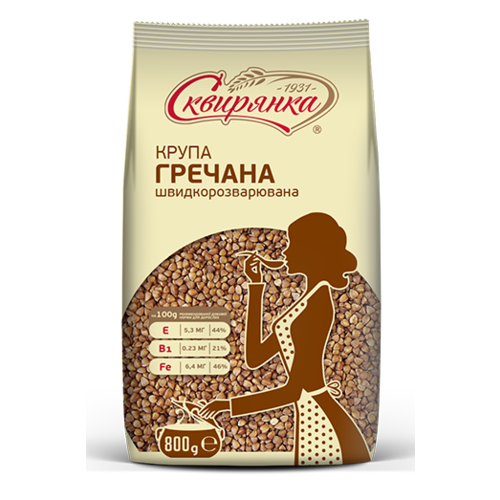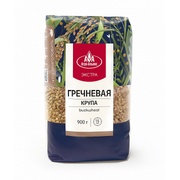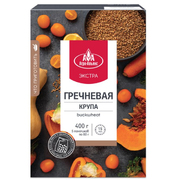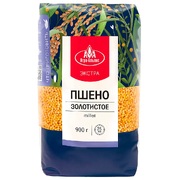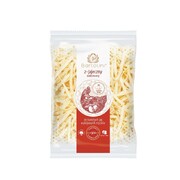Skvirjanka Buckwheat Groats Roasted 0.8kg
Skvirjanka, Ukraine
Notify me when back in stock
Skvirjanka Buckwheat Groats Roasted 0.8kg
Buckwheat is a very good source of manganese and a good source of copper, magnesium, dietary fiber, and phosphorus. Buckwheat contains two flavonoids with significant health-promoting actions: rutin and quercitin. The protein in buckwheat is a high quality protein, containing all eight essential amino acids, including lysine.
Buckwheat grains, or groats, that have not been roasted are known simply as buckwheat, while roasted groats are known by the Russian name "kasha." Kasha also refers to a popular Russian and Eastern European hot cereal or side dish made with roasted buckwheat groats. Roasted buckwheat is darker in color and has a stronger flavor than unroasted buckwheat.
Health benefits of buckwheat.
- Buckwheat grains compose proportionately more starch than other similar seeds like quinoa and amaranth. 100 g seeds (grains) provide 343 calories. Its grains are moderate sources of energy. Calorie content of ts seeds may be compared to that of major cereals such as wheat, maize, rice and that of pulses like chickpea, mung bean, cowpea (black-eye pea), etc.
- The protein level in buckwheat grains is in the range of 11-14 g per 100 g; relatively less than that in quinoa and pulses. Nonetheless, it composes almost all of the indispensable amino acids at excellent proportions, especially lysine which is otherwise a limiting amino acid in grains like wheat, maize, rice, etc.
- Buckwheat seeds are very rich source of soluble and insoluble dietary fiber. 100 g provide 10 g or 26% of daily requirement of fiber. Fiber increase bulkiness of the food and helps prevent constipation problems by speeding up bowel movements through the gut. Fiber also binds to toxins and aid in their excretion through the gut and, thereby help protect colon mucusa from cancers. In addition, dietary fibers bind to bile salts (produced from cholesterol) and decrease their re-absorption in the colon, thus help lower serum LDL cholesterol levels.
- Buckwheat is another gluten-free food source. Gluten is a protein present in certain grass family grains and may induce stomach upset and diarrhea in individuals with Celiac disease.
- The grains compose of several polyphenolic antioxidant compounds such as rutin, tannins and catechin. Rutin (quercetin rutinoside) is found to have anti-inflammatory, and antioxidant properties and help prevent platelet clot formation inside the blood vessels. Early laboratory studies suggest that rutin may offer a cure in hemorrhoids, and clotting disorders.
- Buckwheat grains have more B-complex group of vitamins than that of quinoa seeds, especially riboflavin (vitamin B2) and niacin (vitamin B3).
- Finally, buckwheat has more concentration of minerals like copper, and magnesium. Copper is required for the production of red blood cells. Magnesium relaxes blood vessels leading to brain and found to have curative effects on depression, and headache.
Buckwheat is also ground into flour, available in either light or dark forms, with the darker variety being more nutritious. Since buckwheat does not contain gluten, it is often mixed with some type of gluten-containing flour (such as wheat) for baking. Buckwheat can be safely eaten by people who have celiac disease as it does not contain gluten. Buckwheat can be a good substitute for wheat, oats, rye and barley in a gluten-free diet.
Buckwheat is native to Northern Europe as well as Asia. From the 10th through the 13th century, it was widely cultivated in China. From there, it spread to Europe and Russia in the 14th and 15th centuries, and was introduced in the United States by the Dutch during the 17th century.
Buckwheat is widely produced in Russia and Poland, where it plays an important role in their traditional cuisines. Other countries where buckwheat is cultivated commercially include the United States, Canada, and France, the country famous for its buckwheat crepes.
The three basic techniques for cooking buckwheat with hot liquid are boiling, absorption and steaming, which are perhaps the most popular methods for cooking most whole grains. Often a combination of these methods is used to cook grain depending on the type of grain, the particular recipe, or the desired effect. Some grains benefit from soaking before they are cooked because cooking with hot liquid alone may not produce the optimum results.
Like all grains, buckwheat should be rinsed thoroughly under running water before cooking, and any dirt or debris should be removed. After rinsing, add one part buckwheat to two parts boiling water or broth. After the liquid has returned to a boil, turn down the heat, cover and simmer for about 30 minutes.
Boiling
Boiling is one of the easiest methods for cooking grain. The grain is cooked uncovered in a large quantity of water. The grain and water are then dumped into a colander and drained for several minutes to remove the excess moisture. This method is often the best when there is some doubt as to the correct quantity of water that can be absorbed by the grain.
Absorption
Cooking grain with the absorption method is, perhaps, the method that most people are accustomed to when cooking many types of grain, but it is often the most difficult. This technique requires that the grain be cooked in a specific quantity of liquid, which can be readily absorbed by the grain. The absorption method may require some trial and error, but it is most often successful when slight adjustments are made to recipes based on variables that may affect the success of the absorption cooking method, such as the accuracy of the heat source, the altitude, and age and quality of the grain.
Steaming
Steaming is the third method for cooking grain and although it is the most time consuming, it produces beautifully cooked grain. The grain slowly absorbs moisture and cooks very evenly. Steaming alone usually is not adequate for cooking many types of grain, so it is often used in conjunction with other cooking methods and techniques. Some grains are boiled briefly before they are steamed while others may simply require soaking in cold water for a period of time to tenderize the grains prior to steaming.
Ingredients: buckwheat groats.
Product of Ukraine
Net weight: 800g
(1758)
| SKU | 1758 |
| Brand | Skvirjanka, Ukraine |
| Shipping Weight | 0.8200kg |
| Shipping Width | 0.180m |
| Shipping Height | 0.080m |
| Shipping Length | 0.110m |
| Shipping Cubic | 0.001584000m3 |
While we work to ensure that product information is correct, on occasion manufacturers may alter their ingredient lists. Actual product packaging and materials may contain more and/or different information than that shown on our Web site. We recommend that you do not solely rely on the information presented and that you always read labels, warnings, and directions before using or consuming a product. For additional information about a product, please contact the manufacturer. Content on this site is for reference purposes and is not intended to substitute for advice given by a physician, pharmacist, or other licensed health-care professional. You should not use this information as self-diagnosis or for treating a health problem or disease. Contact your health-care provider immediately if you suspect that you have a medical problem. Information and statements regarding dietary supplements have not been evaluated by the Food and Drug Administration and are not intended to diagnose, treat, cure, or prevent any disease or health condition. Ruski Way Deli & Cafe assumes no liability for inaccuracies or misstatements about products.
Be The First To Review This Product!
Help other Gourmet Planet Pty Ltd users shop smarter by writing reviews for products you have purchased.

